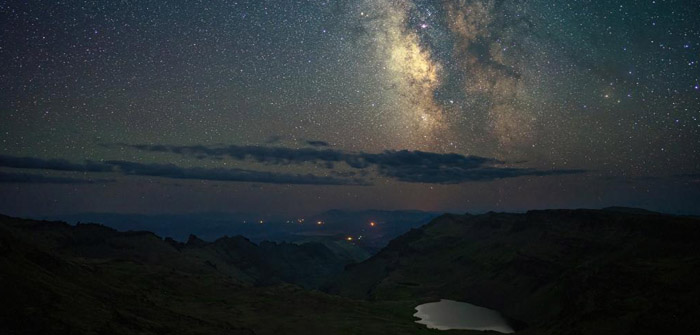(Wildhorse Lake Milky Way | Photo by Joey Hamilton/Travel Oregon)
The Oregon Tourism Commission, dba Travel Oregon, is reminding travelers that several regions in the state will provide excellent viewing opportunities for a spectacular celestial event this fall: the upcoming annular solar eclipse on Saturday, October 14, 2023. The moon, at its furthest point from Earth, will appear smaller as it passes in front of the sun, creating a brilliant “ring of fire” effect. Visitors are encouraged to book their accommodations and other arrangements early — as hotels and campsite reservations are anticipated to sell out quickly — and to anticipate traffic impacts in the path of annularity.
The eclipse will commence its visibility in Oregon shortly after 8am with annularity beginning at 9:14am. This astronomical event will be visible across Oregon’s skies but the best viewing will be in the path of annularity which includes parts of the Oregon Coast and Willamette Valley, a concentrated area within Central Oregon, and much of Southern Oregon — drawing visitors and eclipse-chasers to these areas for excellent visibility, as well as guided tours and events.
If skies are clear on the Oregon Coast, viewers with an unobstructed view of the sunrise between Langlois and Gleneden Beach will see the eclipse first before it traces a southeastward trajectory through Albany, Eugene, Springfield, Crater Lake National Park, Roseburg, Medford, and Lakeview before heading further southeast. The eclipse will reach maximum coverage at 9:16am over the Eugene area, producing near-total darkness. The moon will then begin to clear the sun, completely restoring daylight at about 10:39am.
“Given Oregon’s pristine starry skies, the state is known for its excellent stargazing opportunities and this year’s annular solar eclipse will put on another exciting celestial show,” said Todd Davidson, CEO of Travel Oregon. “With the path of annularity passing through the Oregon Outback and a new moon on the rise that weekend, eclipse-watchers who spend a night or two will also be treated to excellent stargazing.”
This year’s annular solar eclipse differs from the solar eclipse observed over Oregon in 2017 in that the disc of the moon appeared bigger than the sun in 2017 — which created total darkness for two minutes. In October 2023, the disc of the moon will be smaller than the disc of the sun by about 5 percent, and people will be able to see the Ring of Fire for a full four minutes in the path of annularity. The sky will get dark but not fully as dark as in 2017. Animals will become quieter and viewers will be able to see shadows of trees and other landscape elements.
Numerous regions and communities have organized events and other festivities around the upcoming annular solar eclipse. Visitors are encouraged to plan ahead and book accommodations and other arrangements early and keep an eye on the weather forecast and potential traffic impacts as the date approaches. Certified eclipse-viewing glasses will be available at Travel Oregon welcome centers while supplies last.
An interactive map of the eclipse’s path as well as eclipse-viewing information and festivities can be accessed here: traveloregon.com/plan-your-trip/events/how-to-experience-the-annular-solar-eclipse-in-oregon.
Know Before You Go
Helpful travel tips for viewing the annular solar eclipse include:
- Reserve lodging early: Many hotels and campsites in the path of annularity will likely sell out.
- Be prepared for traffic: Many small communities in the path have only one road leading in and out. These could get backed up, making traffic an issue. There are also home football games on eclipse day in both Corvallis and Eugene, which will add to potential backups on I-5 and in those urban areas. To reduce congestion, avoid highways and other popular attractions in the path of the eclipse. Plan to arrive at least one full day, and ideally several days, in advance of the event — and don’t attempt to travel home immediately after the eclipse. If possible, avoid traveling entirely in the path of annularity on October 14, 2023.
- Bring a map: Cell phone and GPS reception can be unreliable in rural Oregon. The increase of cell phone usage will overwork services and make connections tougher. Know where you’re going, and don’t expect to rely on your phone or online maps. Order a highway map online at com or pick one up at a Welcome Center.
- Fuel up: With long distances between gas stations in rural areas, visitors should make sure to calculate their fuel needs.
- Pack provisions: There are a limited number of restaurants in some of Oregon’s beautiful, remote places, and these eateries may run out of food. Stock up on picnic supplies, snacks, water and other essentials in advance.
- Don’t forget to use eclipse glasses: To watch the eclipse safely, viewers will need eclipse-viewing glasses, which block harmful light from damaging vision.
- Carry some cash: The ATMs in many small-to-medium towns are often limited in funds. Most services in Oregon take credit cards; however, there are places in rural areas that only take cash.
- Prepare for variable weather: Fall in Oregon can bring dramatic swings, particularly at elevation where it could be snowing. Visitors should check forecasts and be prepared for all types of weather.
- Be respectful. Don’t trespass: Always respect private property boundaries. Stay on public land, be kind to local communities and wildlife and don’t tread on sensitive habitats.
- Wildfire Prevention: Wildfires are a serious threat in Oregon, so visitors should be vigilant about extinguishing campfires and properly disposing of cigarettes. In addition, visitors should be aware of fire risks and restrictions, including campfire bans. Avoid parking or driving on dry grass, as vehicles can spark a wildfire.
- Avoid Excessive Waste: Consider packing large water containers and refilling them with tap water. Many places in Oregon enjoy excellent tap water, so there’s no need to buy it bottled.
- Pro Photo Tip: Instead of trying to capture images of the eclipse, capture shots of family and friends, as well as the shadows and trees that may look different during the event.
For more information on viewing the annular solar eclipse in Oregon, tap here. For images, see here.
About Travel Oregon:
The Oregon Tourism Commission, dba Travel Oregon, is a semi-independent state agency whose mission is to inspire travel that uplifts Oregon communities. Collaborating with stakeholders to align as stewards of Oregon, we work to optimize economic opportunity, advance equity and respect the ecosystems, cultures and places that make Oregon… Oregon. Travel Oregon aims to improve Oregonians’ quality of life by strengthening the economic impacts of the state’s $13.9 billion tourism industry, which employs more than 100,000 Oregonians.





